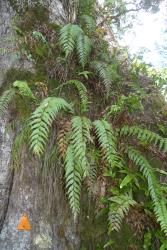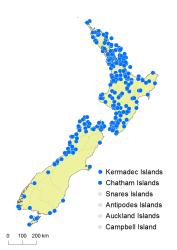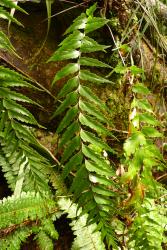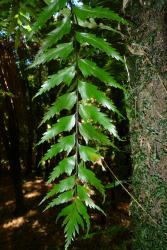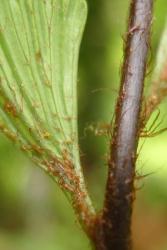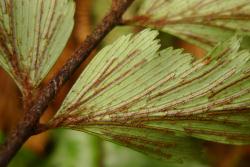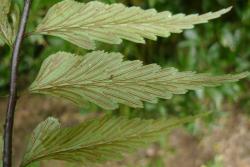- ≡ Tarachia polyodon (G.Forst.) C.Presl, Epimel. Bot. 76 (1851)
- ≡ Asplenium adiantoides var. polyodon (G.Forst.) C.Chr., Index Filic. 126 (1905)
- = Asplenium forsterianum Colenso, Tasmanian J. Nat. Sci. 2: 171 (1845)
Terrestrial, rupestral, or epiphytic ferns. Rhizomes short-creeping or erect, stout, bearing scales. Rhizome scales narrowly triangular, 5–22 mm long, 0.5–2 mm wide, red-brown, clathrate. Fronds 115–1640 mm long. Stipes 45–600 mm long, dark brown, stiff, densely covered throughout in narrowly triangular scales with filiform apices. Rachises chocolate-brown, densely scaly. Laminae 1-pinnate, narrowly elliptic, narrowed to a short pinnatifid terminal segment, 70–1150 mm long, 26–260 mm wide, dark glossy green adaxially, paler dull green abaxially with prominent veins, herbaceous or coriaceous, drooping or pendent, bearing scales on both surfaces, lacking hairs. Primary pinnae in 5–35 pairs below a pinnatifid apical segment, not overlapping; proximal pinnae ovate or narrowly ovate, those at mid-lamina narrowly ovate, often with an enlarged basal acroscopic lobe; the longest at or near the middle, 15–170 mm long, 7–40 mm wide; pinna apices acuminate, margins doubly and often deeply serrate, bases unequally cuneate and stalked. Sori away from margins; indusia 3–30 mm long, slightly curved away from midribs; free margins of indusia entire. Mean spore size 30–37 μm long, 18–21 μm wide; perispores with a few prominent ridges.
Asplenium polyodon is recognised by its long arching or pendent fronds, 1-pinnate laminae, its dark brown and very scaly stipes and rachises, and its pinnae, which are doubly serrate with an enlarged basal acroscopic lobe.
North Island: Northland, Auckland, Volcanic Plateau, Gisborne, Taranaki, Southern North Island.
South Island: Western Nelson, Sounds-Nelson, Marlborough, Westland, Canterbury, Otago, Southland, Fiordland.
Kermadec Islands, Chatham Islands, Stewart Island.
Altitudinal range: 0–920 m.
Asplenium polyodon occurs on Raoul Island, and in lowland to montane areas throughout the North Island, where it ranges from near sea level to over 900 m on Mt Taranaki. In the South Island it occurs in lowland to montane areas of the Marlborough Sounds, north-west Nelson and Westland, with very scattered records in Fiordland, coastal Southland and Otago; there are outlying populations on Banks Peninsula and at the Clarence River, Marlborough. It ranges from near sea level up to 420 m on D’Urville Island. It also occurs on Stewart Island and the Chatham Islands, but was erroneously recorded for the Three Kings Islands by Brownsey & Smith-Dodsworth (2000).
According to Ohlsen et al. (2014), plants belonging to the New Zealand clade probably also occur on Norfolk Island, whilst the broader clade occurs in Australia (Queensland, New South Wales), Lord Howe Island and New Caledonia (see Notes below).
Asplenium polyodon occurs in kauri, podocarp, broadleaved, beech and coastal forest, under mānuka and kānuka, and under Pinus. In the northern part of its range it is usually epiphytic on living trees and on old stumps or logs, or at the bases of trunks, but is sometimes found on the ground, on lava or on thermally heated soil. Further south it also grows terrestrially on soil, rocks, banks, streamsides, cliff faces, and among Phormium. It has been recorded growing epiphytically on Cyathea dealbata, C. smithii, Dicksonia squarrosa, Beilschmiedia tawa, Elaeocarpus dentatus, Fuchsia excorticata, Kunzea spp., Melicytus ramiflorus, Metrosideros spp., Pinus spp., Rhopalostylis sapida, Sophora spp., Vitex lucens, and Weinmannia racemosa and hanging from clumps of Astelia.
Asplenium polyodon is unusual among New Zealand species of the genus in that it has not been recorded hybridising with any other species, despite growing in close proximity to many different taxa (Brownsey 1977a). Its isolated phylogenetic position in Clade VI of Schneider et al. (2004), in contrast to most New Zealand species, which occur in Clade V, may account for this. However, in Australia A. polyodon is known to hybridise with A. attenuatum and A. paleaceum, both of which also occur in Clade VI (Ohlsen et al. 2014).
2n = 144 (Brownsey 1977b).
The names Asplenium adiantoides (based on Trichomanes adiantoides L.), A. caudatum G.Forst., and A. falcatum Sw., and combinations based on them, have been widely misapplied to A. polyodon in New Zealand. Asplenium caudatum is a widespread species of the tropical Pacific that was said to be present on the Kermadec Islands by Hooker (1864), Cheeseman (1906, 1925), and (as A. falcatum var. caudatum) by Allan (1961), but is no longer accepted in the New Zealand flora. The correct applications of the names Trichomanes adiantoides L. and A. falcatum Sw. have been interpreted differently by different authors, but have now been resolved in a detailed investigation of their nomenclature, typification, and taxonomy by Salgado & Fraser-Jenkins (2013). The proposal by Salgado & Fraser-Jenkins (2014) to reject T. adiantoides L. has been accepted (Applequist 2016), and the name A. aethiopicum (Burm.f.) Bech. will continue to be used for the widespread African, Asian, and Australian species, and the name A. falcatum Lam. will apply to the Sri Lankan and south Indian plant. As a consequence of the rejection of Trichomanes adiantoides L., and combinations based on it, the name A. adiantoides var. polyodon (G.Forst.) C.Chr. is incorrectly formed and cannot be used, even though the varietal epithet is legitimate.
Asplenium polyodon G.Forst. is much less widespread than indicated by Brownsey (1998). Salgado & Fraser-Jenkins (2013) suggested that it should be restricted to plants from New Zealand, Australia, and adjacent islands, including New Caledonia, and that it does not apply to plants in Polynesia. However, molecular analysis by Ohlsen et al. (2014) indicates that it is likely to be even more restricted. They identified four related lineages within the Australasian region. One, which includes A. listeri, comprises lithophytes that occur on limestone on Christmas Island, New Caledonia, Vanuatu, and possibly also Tonga. The other three are primarily epiphytic and occur respectively on Christmas Island (and probably elsewhere), in mainland Australia and New Caledonia (and possibly Lord Howe Island), and in New Zealand (and probably also Norfolk Island). Unfortunately the lectotype of A. polyodon (UPS-T 24832), collected by the Forsters in the Pacific, is unlocalised and it is uncertain to which of the clades identified by Ohlsen et al. (2014) it belongs. If it were shown that it belonged to one of the non-New Zealand clades, the plant in New Zealand would require a new name (with A. forsterianum Colenso a likely candidate). However, until that issue is resolved the name A. polyodon is used here in a broad sense for plants in Australasia.



